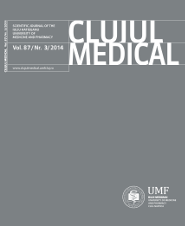Glaucoma Pathophysyology and Therapeutic Implication
DOI:
https://doi.org/10.15386/cjmed-295Keywords:
primary open angle glaucoma, genetic risk factors, oxidative stress, glutathion, nitric oxideAbstract
Primary Open Angle Glaucoma(POAG) is a chronic, irreversible optic neuropathy leading to the progressive death of retinal ganglion cells, clinically observed as silent visual field loss along with a decrease in colour and contrast sensitivity. Multiple pathogenic theories have been issued and some of them have proven their involvement in disease development: mechanical damage due to increased intraocular pressure, variable susceptibility of the optic nerve, mutation in specific nuclear genes, increased glutamate levels, alteration in nitric oxide (NO) metabolism, changes in the mitochondrial genome, vascular dysregulation, and toxic effects and oxidative damage cause by reactive oxygen species1.
The aim of this article is to highlight the pathogenic role of vascular dysregulation and reactive oxygen species in POAG with the further possibilities for prevention and gene therapy.
Downloads
Additional Files
Published
How to Cite
Issue
Section
License
The authors are required to transfer the copyright of the published paper to the journal. This is done by agreeing to sign the Copyright Assignment Form. Whenever the case, authors are also required to send permissions to reproduce material (such as illustrations) from the copyright holder.

The papers published in the journal are licensed under a Creative Commons Attribution-NonCommercial-NoDerivatives 4.0 International License.

